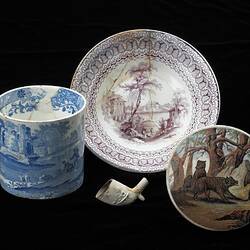Summary
This chamberpot, which has been reconstructed, was excavated at the Commonwealth Block site between 1988 and 2003. The pattern it is decorated with is known as 'Wild Rose' pattern.
Health and hygiene.
'Cleanliness is next to Godliness'. This is a difficult maxim to follow when 'there is not one bath in sixty', when sewerage gathers in cesspits and open drainage channels line the streets.But the residents of Little Lon did practice personal hygiene. Archaeologists have uncovered toothbrushes and toothpaste pots, scent bottles, soap dishes, combs and hairbrushes.
Clean teeth and neat hair did not guarantee good health however. Doctors were expensive, so ordinary people had to rely on medicines like Holloway's Ointment and Hall's Vegetable Pain Conqueror as well as Chinese herbal remedies. Children were dosed weekly with the laxative castor oil, to keep their bowels regular.
Physical Description
This is a ceramic chamberpot. It is decorated with a 'Wild Rose' pattern which depicts a floral and geometric design on the rim and a scenic design on the face, outerside and handle in a blue and white transfer printed underglaze design.
Physical Description
Ceramic chamberpot, almost complete, and other fragment with same pattern. Blue & white transfer printed underglaze design, rim: floral/ geometric, face, outerside and handle: scenic. 1 other rim fragment with same design. No manufacturers mark. Christine Williamson, archaeologist, Latrobe Uni., suggests date 1850-1880. Although unmarked, rim design can be identified as 'Wild Rose' which was popular between 1830 - 1850's, produced by around 20 different manufacturer
More Information
-
Collection Names
-
Collecting Areas
-
Acquisition Information
Transfer from Heritage Victoria, Industry Superannuation Property Trust, 03 May 2005
-
Manufacture Date
-
Context Number
57/13
-
Site
[TCS] Australia, Victoria, Commonwealth Block, Melbourne
-
Activity
-
Specific Activity
-
Decoration
-
Colour
Blue
-
Moulding
Wild Rose
-
Form
Flanged Rim; Pedestal Foot (Base)
-
Shape
Round
-
Technique
-
Provenance
England
-
Classification
-
Category
-
Discipline
-
Type of item
-
Object Measurements
250 mm (Width), 125 mm (Height)
-
Dimensions
13 cm (Height), 21.5 cm (Outside Diameter)
Measurement From Conservation. Measuring Method: Not including handle
-
References
A.W. Coysh & R.K. Henrywood 'The Dictonary of Blue & White Printed Pottery
399 - 401 Pages
-
Keywords


